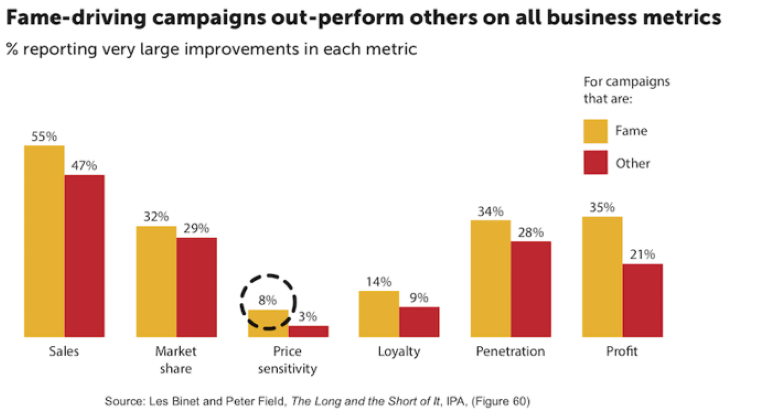#1 – Emotions yield stronger business results.
A constant thorn I get from communications and marketing professionals is the total, unyielding organisational focus on the product. Sales over brand. Rational over-emotional. It shouldn’t be an either/or. It’s an ‘and and’.
But to win internal arguments, we need to be more adept at changing our language and the story. I love finance people, but don’t talk to them about the power of brand – they might get excited by the allure of brand talk, but they’re driven by the power of numbers.
Don’t talk to CEO’s about brand equity; talk to them about what brand equity means to their business, in their language.
I have a passion for building stronger brands by helping people to be better. Not everyone shares that passion.
So find a way to break through internal barriers by engaging with key stakeholders on their terms using language they understand.

Source: Peter Field, IPA
#2 – Helping employees understand how they connect to business goals and direction can improve performance by up to 10%.
Call it purpose, call it positioning, call it brand DNA, call it whatever you like. But if the words and the sentiment fail to connect to your workforce, you’re missing out on a potential 10% jump in performance. And that feels quite conservative to me. Meaningful employee engagement delivers better performance. Fact.

Source: Gartner.
#3 – The power of integration.
I like to think most people in marketing communications – agencies and clients alike – get it.
An idea surrounded by more than one platform makes the idea bigger and often creates a long tail of equity benefits.
But the journey to activating more than one platform can often be arduous. So people give up. Sometimes it’s the idea itself. Sometimes the idea doesn’t translate. Or it’s just not a good idea.
Sometimes those silos, everyone has been trying to break down for generations, are still going strong. Sometimes the idea was only meant for one channel. Sometimes it’s because other channel heads don’t get it or they’re reluctant to do anything with it.
But integration is just better. It’s the result of meaningful collaboration. It happens when you bring people into the conversation early. Not at the end.
If your channels aren’t working in harmony, it’s either the idea or the people. Or both.
We can help with both.

Source: Analytic Partners
#4 – A reputation for sustainability drives growth
The keyword here is reputation. Not doing things for the sake of them.
But doing them because you’re willing to stake your reputation on it.
- Doing good can be profitable.
- Making sure people know about it, makes it more profitable.
- Ensuring your reputation grows will continue to deliver value growth over the long term.

Source: BrandZ/Kantar
#5 of 10 – For earned to be successful, it needs owned and paid to be in place
The best way to create online word-of-mouth and buzz for your brand?
Combine earned, owned and paid.
It creates a multiplier effect – e.g. 1+1+1 = 10 – as evidenced by data from the IPA.
Without all three lined up and without paid investment, the road to meaningful and stronger brand fame can be a mighty slow and painful one.

Source: IPA Databank
#6 – Brands should invest to build 60% in brand equity (long term investment returns big dividends) and 40% in sales activation (driving short-term uplifts).
But that’s not the only story. The optimum mix varies by category, by brand maturity and by what the business is trying to achieve. A question we get asked a lot is,
what should a B2B brand do differently to a B2C brand?
The answer is here. Alter the optimum mix slightly but not by as much as you might think.
The majority of B2B brands continue to pile 85%+ of investment into sales activation so if you’re reading this and you’re in charge of a B2B brand – start investing in the brand and in 2-5 years (depending on where you spend, when you spend it, how much and what on) you’ll be getting an edge on the competition.

Source: IPA Databank
#7 of 10 – Reach versus niche
Which is better – going for broad reach? Or going hyper-targeted? Does the answer differ if you’re a mature brand or a start-up? Is reach more relevant to acquiring new customers or is being hyper-targeted better for existing customers?
For decades, the debate has largely been contextualised around either/or. When in reality the answer is and/and.
And it pretty much ties into investing 60% of the budget into long-term, brand equity building activity and 40% into sales activation.
The broader the reach, the broader the business effects over the long- term, which pay you back year after year. And when combined with hyper-targeted sales activation, you get the best of both worlds.
A stronger brand and a more profitable business.

Source: Long and the Short of It, IPA, Les Binet and Peter Field
#8 of 10 – Great strategy is at the heart of building a trusted brand
Brand strategy is the most sought-after capability as ranked by marketers. It’s hopefully a crucial turning point in what has been a decade of dumbing-down marketing.
For a business to get back to building a blinding strategy two key things need to happen.
- The role of the CMO must be restored to the C-suite and given priority. Too many companies have relegated the CMO from the C-suite or devalued the role to such an extent that what they end up with are plans based purely on performance marketing. That is – marketing that delivers short term sales rather than building a brand that builds sales over time.
- The second is to balance the appetite for creativity with a need for a strong strategy. An idea without strategy is ultimately a tactic doomed to fail. But over the past ten or so years, the narrative around brands has switched to creativity being the key driver of business impacts. It’s true, it does. But only if it is informed and directed by great brand strategy. And the market is short on great strategists or companies that believe in it.
Marketers now realise what many of us have been saying for years. Let’s get back to creating a brilliant strategy. Let’s return to business leaders believing in great marketing. Then let’s create spellbinding campaigns that deliver outstanding results.
#9 of 10 – “You’ve got big dreams? Do you want fame? Well, fame costs. And right here is where you start paying … in sweat.”
The red thread in all of these charts, if you haven’t guessed by now, is strategy.
Better strategy equals better creativity equals better business performance.
So, while the quote from Fame, is about four teenagers going through an academy, looking for stardom, the same applies to brands.
The hard yards are in understanding how to make your brand relevant, distinctive and different in the minds of your consumers.
The stronger the positioning, the greater the chance of success.
And what should you aim for if you have most of your pieces in place?
Brand fame. Every time.
From start-up to the global player, from niche to mainstream, brand fame campaigns out-perform all others on all business metrics.
If you don’t believe me, look at the chart from Les Binet and Peter Field. They analysed hundreds of campaigns from a wide variety of brands on the IPA (Institute of Practitioners in Advertising) Databank.
These campaigns are not your regular, run of the mill award entries. These are campaigns that beat all others for effectiveness and which had to submit a huge amount of data and detail to back up their claims.
They found that campaigns that focussed on building brand fame, delivered more business metrics than all other types of campaign.
What does this mean?
It means when you’re constructing your strategy which feeds into creativity, a critical objective should be to deliver fame.
Budget will be a factor as will the size of the target audience and your spend versus the competitive set.
But, by being clever, by identifying the opportunity to get into the minds of your target consumers, you can build brand trust at pace and business performance over time.
#10 of 10charts f – build sales in the short and long-term
In 2013, Les Binet and Peter Field published research which what was to lead to a paradigm shift in the way marketers and business think.
Well, I say that but actually, that’s crap.
The vast majority of brands and businesses have still not heard or read or have done anything about the research.
Agencies fail to grasp its significance and therefore don’t advise and steer their clients wisely. And that’s ok.
Because the longer businesses carry on in the dark, the greater the opportunity for more clued-up brands and our clients.
Here’s a snapshot of what the research continues to tell us.
If you’re an established brand, the ideal way to invest your hard-earned marketing dollars is to devote 40% to performance marketing (ie product-driven sales) and 60% to brand building.
The sales from brand building deliver over time.
That’s the trick. That’s why so many brands fail because they look for a return in year one or two.
A business that only ever chases the quick pound, will, at some point, resort to dropping the price and from that path, they never return.
Unless you happen to be Stella Artois and it took them over two decades to rebuild the brand.
Binet is Head of Effectiveness at adam&eveDDB and is recognised as an expert in econometrics. He has won more effective awards than anyone else in the UK. Peter Field is an out and out expert on Advertising Effectiveness.
Believe what they say. Or prepare to fail.









